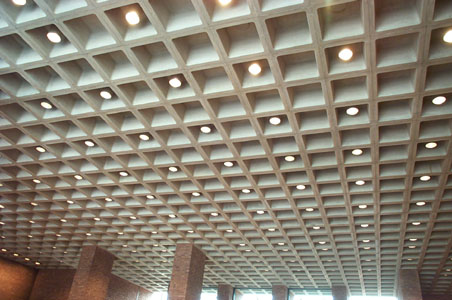Waffle Slab

Description
Waffle slabs are always cast in situ and are rarely post tensioned. Waffle slabs are similar to ribbed slabs. The main difference is that a waffle slab can carry in two directions which makes it more efficient for square room layouts. The ribs are usually about five times as high as the “flat slab” on top and therefore very stiff. The ribs are similarly reinforced to an ordinary beam with longitudinal reinforcement and stirrups. In order to decrease deformations, the ribs can be made continuous. Waffle slabs are of great use in open floor layouts with big spans carried only by columns because the ribs have a high stiffness and can direct all the force to the columns in both directions. Punching failure can be avoided by filling out the empty spaces between the ribs close to the columns. The economic span is with 7 to 15 m the same as for ribbed slabs.
The fire resistance of a waffle slab is dependent on the thickness of the ribs and the “flat slab” on top. For thicknesses over 120 mm, the fire resistance can be assumed to be 120 min.
The flexibility of the geometry is pretty good, because it is cast in situ and a two-way slab. The only limiting factor are the ribs which cannot be altered much, which ranks it behind the flat slab. The flexibility on site is quite good though because short term changes can still be made to a certain extent. Building systems can also be put in the empty space between the ribs or included in the slab itself. The complexity is high, because of the complex formwork and time-consuming reinforcement arrangements. The construction takes a lot of time, due to the required formwork and the curing time of the concrete.
As in most concrete floors, vibration is not a concern due to the large weight.
For a square floor layout, the slenderness l/h lays around 20 but is dependent on the amount of reinforcement included.
Database
Floor type |
Waffle Slab |
||
|---|---|---|---|
Materials |
concrete_prestressed strands or reinforcing steel |
||
Description |
ribbed slab in 2 directions |
||
Way of carrying |
Does the main span carry in one or two directions? |
two way slab |
|
Span width low [m] |
Economically possible |
7 |
|
Span width high [m] |
Economically possible |
15 |
|
Additional measures when installing |
formwork_propping up |
||
Prefab? |
Is prefab possible? |
yes/no |
|
Continous slab? |
Can you build the slab with supports in middle of the slab? |
no |
|
Building systems integratable? |
Can buildings systems be included into the slab itself? |
yes |
|
Fire |
Fireresistance without costly measures [min] |
60 |
|
Substructure |
Certain prerequisites necessary? |
no |
|
Prone to vibration |
no |
||
Environment |
General classification including formwork |
1 to 5 terrible to very good |
2 |
Construction time |
Time on site |
1 to 5 very slow to very fast |
1 |
Flexibility |
Average of the next two |
1 to 5 |
4 |
Flexibility on site |
How flexible is the system to spontaneous changes on site? |
1 to 5 terrible to very good |
4 |
Flexibility geometry |
How good can you adapt the slab to complex geometries? |
1 to 5 not at all to very easy |
4 |
Complexity |
Average of the next two |
1 to 5 |
2 |
Complexity fabrication |
Complexity of floor itself. |
1 to 5 very complicated to very simple |
2 |
Complexity installation |
Complexity installation on site |
1 to 5 very complicated to very simple |
2 |
Slenderness l/h 3kPa |
Applied load (without selfweight) |
Residential building |
22 |
Slenderness l/h 4kPa |
Applied load (without selfweight) |
Office building |
21 |
Weight [kN/m3] |
per m2 and total height of slab |
11.2 |
|
Embodied energy [MJ/m3] |
per m2 and total height of slab |
2677 |
References
- General information:
Goodchild, C., Webster, R., & Elliott, K. (2009). Economic Concrete Fram Elements to Eurocode 2. Camberley UK: The Concrete Centre.
https://www.azukotech.com/post/2019/10/26/waffle-slab-purpose-uses-advantages-and-disadvantages
https://civildigital.com/ribbed-waffle-slab-system-advantages-disadvantages/- Span width:
7 - 12m (Goodchild, C., Webster, R., & Elliott, K. (2009). Economic Concrete Fram Elements to Eurocode 2. Camberley UK: The Concrete Centre.)
7 - 12m (Cement and Concrete Association of Australia. (2003). Guide to Long-Span Concrete Floors. Sydney.)
7 - 16m (https://www.dimensions.com/element/two-way-concrete-waffle-slab-floor-system)
7.5 - 16.5m (https://civilread.com/16-different-types-slabs-construction/#:~:text=What%20is%20a%20Slab%3F,columns%2C%20or%20by%20the%20ground)- Fire resistance:
60min (Goodchild, C., Webster, R., & Elliott, K. (2009). Economic Concrete Fram Elements to Eurocode 2. Camberley UK: The Concrete Centre.)
- Slenderness:
l/h=21 for 3kPa, l/h=19 for 4kPa (Goodchild, C., Webster, R., & Elliott, K. (2009). Economic Concrete Fram Elements to Eurocode 2. Camberley UK: The Concrete Centre.)
l/h=24 for 3kPa, l/h=24 for 4kPa (https://www.dimensions.com/element/two-way-concrete-waffle-slab-floor-system)- Photo Source: